Traumatic dental injuries are common in adolescents especially among those who play sports. Most dental injuries involve chipped teeth and less frequently are dislodged or “knocked-out” teeth.
There are a variety of ways where the dentition can be involved in a trauma:
- Concussion—No loosening or displacement, tender to palpation.
- Subluxation—Loosening but no radiographic/clinical displacement.
- Lateral luxation—displaced laterally.
- Intrusive luxation—displaced apically into alveolus.
- Extrusive luxation—displaced coronally, partially out of socket.
- Avulsion—displaced completely out of socket.
Treatments with different injuries will vary: A concussion injury, treatment is reassurance and advice to not bite on injured tooth for 3 days. Follow up will be needed to evaluate the vitality of the tooth. Subluxation injury, relieve occlusal contacts, soft diet and avoid biting on traumatized teeth. Splinting has not been shown to improve healing. Follow ups should be performed as 12% will lose vitality. Lateral luxation injury, reposition tooth with gentle digital pressure, splint for 10 days. Remove splint and have patient return to function to avoid ankylosis. Intrusive luxation, with damage to blood supply and nerve will lead to pulp necrosis and infection. Will want to reposition the tooth and provide endodontic therapy with in 3-4 weeks before external root resorption occurs. Extrusive luxation, the tooth should be repositioned with firm digital pressure and splinted for 10 days. Regular follow up is needed to evaluate for pulpal necrosis. Avulsion, immediate replacement in the socket is ideal treatment. Inform parents if can’t place tooth back into socket, place in milk or Hank’s balanced salt solution. If left out too long >30 minutes, external resorption is likely as the tooth is non vital.
Posted on behalf of
23451 Madison St #120
Torrance, CA 90505
Phone: (310) 373-0667
Monday - Friday 8AM - 5PM
